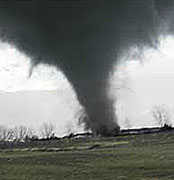
Like moths to firelight, people seem mesmerized by tornadoes. What is the fascination that causes them to stand transfixed, staring down this soul-chilling fury?
Russell Sloan, who lives near the intersection of routes 96 and 43 in Carl Junction, told us that he found himself rooted to the ground as a dark funnel cloud approached the corner of his property. He just had enough time to jump into his nearby whirlpool spa and close the cover before the tornado hop-scotched across his yard.
Other people admit to standing by windows and doorways hoping to catch a glimpse of the demon. Many people refuse to heed the warning sirens until the tornado is practically on their doorstop. There were reports of almost a dozen people in Pierce City who were watching the sky when the tornado came barreling down upon them. They chose almost the last minute to run into the National Guard Armory Building, not a wise choice, as it turned out.
Driving in the direction of an impending tornado seems to be an obviously bad idea, but not for one Missouri woman who wanted to reach a relative in Kansas whom she thought would need her assistance. Instead of reaching her destination, she found herself in one of the storm's direct paths, had to pull over, crouch down and pray. She was lucky. All the windows in her vehicle were blown out, but she survived, hopefully having learned a lesson that man is no match against nature's fury.
Freud's theories
Sigmund Freud in 1930 in Civilization and Its Discontents described the goal of governments to "combine the human community and take up the attack on Nature, thus forcing it to obey human will, under the guidance of science." Are Man and Nature as independent of each other as Freud suggested? And will Nature bend to the will of man or will its non-predictability remain unchallenged?
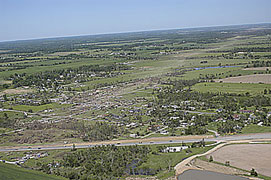
A swath of tornadic destruction can be seen in the area between Alma and Frontenac in southwest Kansas. The town of Franklin, population about 800, was in the tornado's path.
Comparing tornadoes to other forms of natural disaster, tornadoes are the least predictable. An account of a tornadic storm might include the adjectives "terrifying," "freakish," or even "whimsical." Man is amazed to encounter total destruction in one area while another, perhaps, a few feet away, remains unscathed.
At least a third of all the tornadoes in the United States wreak havoc on this area of the Midwest. Known as Tornado Alley, an area that includes about 22,500 square miles, it spawns the most violent tornadoes when warm, moist air flowing up from the Gulf of Mexico meets a dry line from the north.
This sort of meteorological information was known about a week before the recent storms hit the Kansas/Missouri area. How to tell the public to prepare for the possibility of them approaching apparently has not been perfected.
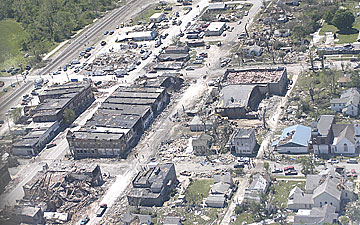
Downtown Pierce City, is now in ruins after the wake of a tornado on May 4 that ripped apart its stone and brick structures. It had been a popular stop on the tour bus route because of its charming late 1800's flavor. Destroyed--among other businesses--were several antiques stores, the Rhinehart Art Ltd. Gallery and the Windsor Room Restaurant.
Tornadoes take on many forms. They may be skinny or fat, look as white as the whitest cloud or as black as the soot they pick up or as red---if they pick up seeds from a milo field. They hang around for just a few minutes or a few hours, and they may pinpoint a narrow area or travel for several miles. The tornado that struck Pierce City, according to a report by a worker for Empire District, touched down on the outskirts of the city, ripped down its main streets, and then headed about 40 miles until it petered out around Battlefield. Other signs of tornadoes showed no pattern at all.
Predictability of Doppler radar
The most reliable technology for tornado detection appears to be Doppler radar. KODE-TV in the Joplin area is part of The Next Generation Weather Radar system (NEXRAD) one of approximately 160 Weather Surveillance Radar-1988 Doppler (WSR-88D) sites throughout the United States. KSN relies on Freeman Super Doppler contributed and supported by Freeman Hospital, while KOAM-TV uses what they call Doppler 7000 and a weather system supported by St. John's Medical Center.
Exploiting the Doppler effect--that the pitch of a sound approaching or moving away from an observer rises or falls--the detector may show an abrupt change on the screen indicating a rotation. Doppler radar may be able to identify incipient rotational circulations within a storm as much as 30 minutes before the formation of a tornado, although many storms capable of producing a tornado do not have clear-cut radar signatures or else give out false ones. In addition, judging this evidence, particularly "hook echoes" in the rainfall pattern of a storm on a radar screen is often "a subjective process," according to the American Meteorological Society.
Satellite images sometimes detect cloud formations that presage tornadoes. Mammatus clouds, caused by the sinking of moist, cold air often hint at turmoil above them. Tim Marshall, a meteorologist, civil engineer and dedicated storm chaser, has described the classic tornado storm structure as a "rain-free cloud base--ragged and turbulent with a tail cloud extending off to the north." Tornadoes also frequently come out of a wall cloud.

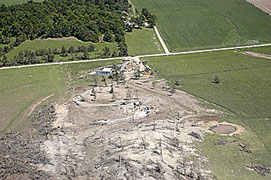
Left, the markings that appear to be random swiggles in the ground, as seen from the air, suggest the capriciousness of tornadoes as they touch down and gouge the earth, then shrivel and re-form nearby or in another location miles away. Right, a burned out section of land was once a grove of trees. Miles of downed trees could be seen in an area around Liberal, MO and Highway 43.
The destructiveness of a tornado and the capriciousness of them depend upon the magnitude of the tornado's rotation, its complexity and its severe effect on atmospheric pressure. What little is known about a tornado is that when it strikes a structure like a house, the structure behaves like an airplane wing. The tornadic wind rushes at the front wall, and this barrier--if it is still standing--forces the wind over the roof and the side walls of the structure, and creates air inside now at a higher pressure which exerts a thrust on the roof and remaining walls. According to calculations by structural engineers, a wind speed of 160-mph produces a lifting force of over 30 tons on a typical structure--double the wind speed not unusual with a tornado and the lifting force is 100 tons!
According to a narrative by Andrew Robinson, author of the book, Earth Shock:
The usual effect is that the roof lifts up, weakening the walls. Then the front wall blows in, the side walls blow out, and the rear wall falls down and out; finally the roof falls in. But neither roof nor walls are necessarily swept away. They are much harder to lift when lying flat on the ground than they are when upright.
Although the theory has not changed, according to Robinson, the advice to homeowners threatened by a tornado that used to be opening the windows to equalize the pressure, has changed to keeping the windows closed. This avoids the possibility of updraft within the house caused by windows open on the windward side as well as wind-driven rain.
Robinson also mentions the explosive pressure difference in tornadoes that accounts also for the "curious way" in which they sometimes pull apart masonry, brick by flying brick, while leaving the interior of a structure unscathed. While one would normally expect the wind to blow the bricks inward, it causes the brick walls to crumble outwards, exposing interior materials that fly off willy-nilly in all directions, acting as killer projectiles.
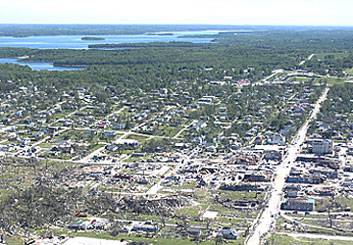
An overview of Stockton, MO shows the damage to the downtown caused by the tornado that hit the area on May 4. Streets on either side of the courthouse (pictured about middle, extreme right) were heavily damaged, while sailboats moored at marinas at Stockton Lake worth hundreds of thousands of dollars were spared. Speaking of money, all that was left of a Stockton bank was its vault. Tellers in blue jeans sitting on lawn chairs in front of the vault were conducting business today as police stood nearby.
Destroyed buildings in the downtown districts of Pierce City and Stockton and the Pennell St. section of Carl Junction are examples of the havoc tornadic winds can wreak on seemingly impenetrable structures. Tornadic winds destroy anything in their path, not just mobile home parks. If home, people need to decide where the safest place might be to weather out the storm--current thinking is the lowest level of the house, inner closets or porcelain bath tubs-- and then stay there until it is safe to survey the damage.
Take this tornado test here.
Assistance centers are set up
People wishing to make donations of non-perishable food; household goods; and usable, clean clothing, should check out the following websites:
Look also for a couple of donated CFI rigs in the parking lot alongside the new Zimmer Radio Group building on 32nd Street near Food 4 Less where donations may be brought.
RECOMMENDED WEBSITES:
Updated and accurate general storm and disaster recovery information is available at: Outreach Missouri.
For additional info about organizations providing assistance or what they can do, click here.






Comments